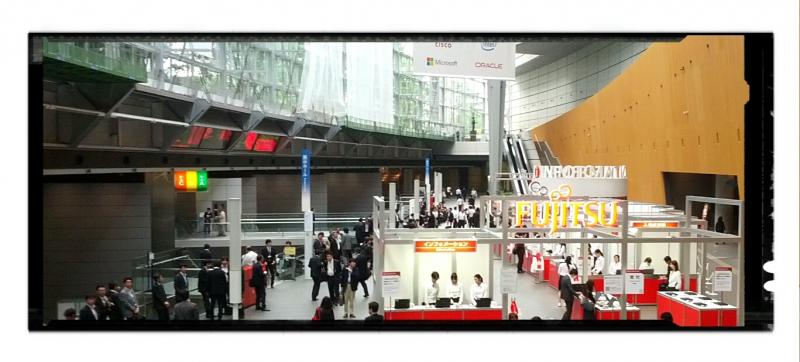Fujitsu Lays Out Its “Human-Centric Intelligent Society” Vision And Strategy

Dan Bieler, Chris Mines, John McCarthy
Ten days ago, three of us traveled to Japan for a Fujitsu analyst day held in conjunction with the firm’s huge customer event – the Fujitsu Forum. The analyst day was a follow-on from the firm’s European event last fall. At the two events, the management team, led by Masami Yamamoto, president and representative director, and Rod Vawdrey, the president of Fujitsu’s International Business, talked about the organization’s vision and key imperatives:
- Creating a common vision around “Human-Centric Intelligent Society.” Management highlighted publishing the firm’s global vision document. Speakers repeatedly pointed toward Fujitsu’s new “human-centric” vision for how information technology improves business, personal, and societal outcomes. Fujitsu is positioning itself as a provider of solutions aimed at facilitating the activities of consumers and businesses, combining elements of its hardware, software, and services portfolio.
- Standardizing its solution offerings and implementing a common set of processes globally. As part of its move to a global delivery model, Fujitsu is following peers like Accenture, HP, and IBM in standardizing its portfolio and processes. The firm now has seven core, globally consistent offerings. In parallel, the firm is moving to a common set of tools and processes across its nine global delivery centers and 12 in-region centers. The company is migrating to salesforce.com globally, and in Japan, it is replacing 45 different ERP and billing systems with SAP.
- Developing a center of excellence (COE) model as part of its “think local, leverage global” mantra. As the company tries to expand its geographic revenue mix outside of Japan (currently, 68% of revenues are domestic), it’s building a COE strategy to leverage the synergy with what is happening in local markets like Australia, the UK, and the US with the depth of engineering resources it has in Japan as part of a think local, leverage global strategy.
- Establish its end-to-end positioning and differentiation. A number of executives said that what would differentiate Fujitsu was its integrated portfolio – hardware, software, and services. Dr. Joseph Reger, CTO for Fujitsu Technology solutions, stated that being an ICT company is also a key part of the firm’s positioning.
Fujitsu Needs To Go External and Address Fundamental Industry Shifts
While the company deserves credit for its vision and internal changes, there are four key external changes that it will also need to address over the next 24 months if the firm is going to be a competitive global technology supplier:
- The rise of the business buyer as a major IT decision and spending stakeholder. The industry’s customer base is changing. Business executives and managers with clear business-line objectives are increasingly important, while the influence and budgets of traditional technology-focused procurement officers or IT managers wane. As asecond-tier supplier outside Japan, the company needs a strong business case as to why business executives should consider Fujitsu. This means articulating the business value of a solution, going beyond the traditional tech approach of speeds and feeds. For example, its positioning as an end-to-end ICT supplier does not resonate with business buyers looking for innovation to grow their businesses or address rising customer expectations.
- The shift to app-led innovation and systems of engagement. The perfect storm of technology innovation around mobile is driving a shift to a whole new class of systems of engagement. These new applications empower people with context-rich apps that merge the physical context from the mobile device, smart products, and M2M with virtual intelligence from traditional transaction systems to help customers, partners, and employees take the next most likely action. These investments, championed by the business buyer, will require a solutioning architect approach that mixes sales, industry, and technical expertise.
- The broadening of the innovation ecosystem. Given the accelerating rate of change and business innovation, one of the biggest challenges facing Fujitsu is the need to build a broader ecosystem of business partners. The classic example of this change is the fact that since February, IBM has been an Apple reseller. The attributes of its home market – the corporate start-up rate in Japan is the lowest in OECD countries, according to a World Bank Study – and of its clients who rely on Fujitsu to build custom applications look to us to be far apart from the dynamics shaping the developed and emerging markets where Fujitsu wants to grow. It is telling that, despite its grand globalization plan, only 1,000 of its 105,000 Japanese employees are on assignment outside Japan.
- Customer preference for a more elastic public cloud infrastructure.While Fujitsu has been more aggressive in this area, it needs to link its cloud initiatives to mobile and the building of systems of engagement. To do that, it needs to be recruiting innovative start-ups in the Valley and positioning its cloud offerings to be “engagement critical” and not about moving legacy workloads.
Fujitsu clearly brings a broad array of assets and skills to the table. However, despite the progress that we saw at the Forum, like deploying cloud store across Europe and introducing backup-as-a-service, we feel that the company has not yet developed a true sense of urgency that will be required to defend and expand its position in a rapidly changing market environment. Fujitsu is aiming to cover a too-wide portfolio of geographies and product/service segments. Given its annual revenue base of nearly $44 billion, Fujitsu remains a surprisingly small global ICT player. Management was clear in recognizing the need for investment in small-but-growing markets like Latin America, but given limited resources, we did not hear enough about priorities and tradeoffs. Given flat revenue performance in recent years, and an EBIT margin hovering around the 2% mark, thin cash flow from operations severely limits its investment capabilities. We expect further sharpening of the product portfolio and geographic priorities over the next 18 months.
